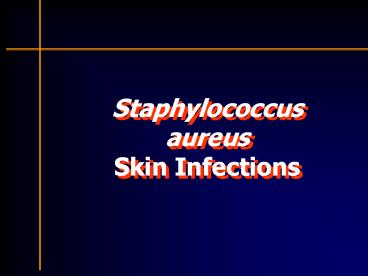Staphylococcus%20aureus%20Skin%20Infections PowerPoint PPT Presentation
Title: Staphylococcus%20aureus%20Skin%20Infections
1
Staphylococcus aureus Skin Infections
2
Typical Staph Skin Infections
3
- Staph aureus are bacteria that commonly cause
skin infections. - 20 to 30 of healthy people have Staph on their
skin. - Staph are resistant to some antibiotics, but all
Staph infections can be treated with one or more
antibiotics. - Some populations, like athletes, military
recruits, children, and prisoners are at higher
risk of Staph infections. - The risk of infection is increased when there are
cuts in the skin, close skin-to-skin contact,
crowded living conditions, poor hygiene, and
contaminated items and surfaces.
4
- Staph infection can be prevented through
practicing good hygiene 1. Keep hands clean by
washing with soap and water or using an
alcohol-based hand sanitizer. 2. Keep cuts and
scrapes clean and covered with a bandage until
healed. 3. Avoid contact with other peoples
wounds and bandages 4. Avoid sharing personal
items such as towels or razors. - Employees and students with Staph infections do
not need to be excluded from work or school if
their wounds are clean and covered.
5
S. aureus Colonization
- About 30 of people are COLONIZED
- Average 2.8 strains /person
- Colonization more frequent in
- Newborns
- Hemodialysis patients
- People with skin diseases like dermatitis, eczema
- Diabetics
- Colonization may last for months to years
6
Sites of Colonization
- IN and Around the NOSE
- WOUNDS
- Armpit, groin, genital and perianal area, rectum
7
Mode of Transmission
- From person to person by colonized hands
- Rarely from environment
- General routine cleaning disinfection of
housekeeping surfaces and patient-care surfaces
adequate for inactivation of MRSA - MRSA susceptible to many low-level and
intermediate-level disinfectants - One tablespoon of bleach in a gallon of water
8
Community Outbreaks
- Competitive sports
- Correctional facilities
- School
- Day care centers
- Families
9
Prevention of Staph infection
- Promote good hygienic standards
- Handwashing, plain soap OK
- Showers
- Do not pick, press, touch wounds, boils and other
skin infections - Avoid sharing personal items like towels and
razors
PowerShow.com is a leading presentation sharing website. It has millions of presentations already uploaded and available with 1,000s more being uploaded by its users every day. Whatever your area of interest, here you’ll be able to find and view presentations you’ll love and possibly download. And, best of all, it is completely free and easy to use.
You might even have a presentation you’d like to share with others. If so, just upload it to PowerShow.com. We’ll convert it to an HTML5 slideshow that includes all the media types you’ve already added: audio, video, music, pictures, animations and transition effects. Then you can share it with your target audience as well as PowerShow.com’s millions of monthly visitors. And, again, it’s all free.
About the Developers
PowerShow.com is brought to you by CrystalGraphics, the award-winning developer and market-leading publisher of rich-media enhancement products for presentations. Our product offerings include millions of PowerPoint templates, diagrams, animated 3D characters and more.

